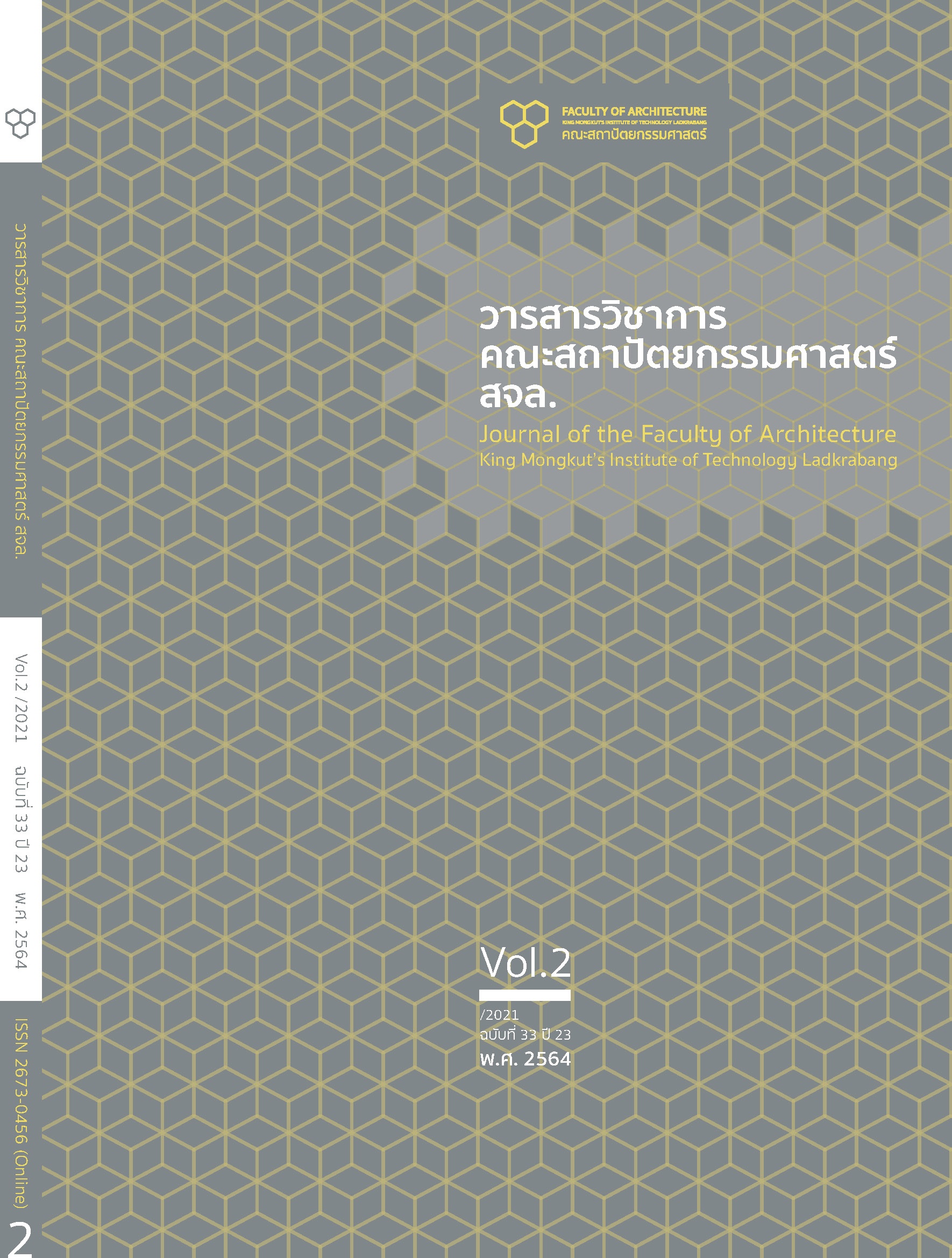Enhancing the Potential of Landscape Elements to Facilitate Exercise Activities in Neighbourhood Parks
Main Article Content
Abstract
This research aims to study physical conditions and the activities that can be done in each of the five neighborhood parks in the Phra Nakhon area, Bangkok. The aforementioned public parks include Lan Khon Meaung, Saranrom Park, Unakan Park, Museum Siam Park, and Phra Pok Klao Bridge Park, all of them were selected as representatives of different types of open spaces based on the locations. The data was collected by observations of the physical conditions and physical activities that took place in these particular areas. Moreover, questionnaires were distributed and interviews of 100 random people were conducted to survey their satisfaction levels. The analysis revealed that first, there should be improvements of the physical conditions that facilitate exercises in all of these parks in terms of traffic, usable areas, and aesthetics. Second, landscape elements, both hardscape and softscape elements, which corresponded with types of exercises could be divided as follows. The first category was the main elements including fixed pavement, flexible pavement, and the yard. The second type belonged to secondary elements such as trees, shrubs, and ground covers. The third type included additional elements, referring to other hardscape elements. There were certain suggestions proposed as follows. First, the design of an environment that facilitates exercises should adopt design principles that increase awareness and attract people’s attention with naturalness, legibility, and complexity. Furthermore, the design of the landscape components that impact physical exercises should entail the main elements that are able to accommodate heavy traffic as well as physical activities. Lastly, the secondary elements should be able to enhance the comfort of the atmosphere, and the additional elements should appropriately blend in with physical exercises.
Article Details
This work is licensed under a Creative Commons Attribution-NonCommercial-ShareAlike 4.0 International License.
Copyright Transfer Statement
The copyright of this article is transferred to Journal of The Faculty of Architecture King Mongkut's Institute of Technology Ladkrabang with effect if and when the article is accepted for publication. The copyright transfer covers the exclusive right to reproduce and distribute the article, including reprints, translations, photographic reproductions, electronic form (offline, online) or any other reproductions of similar nature.
The author warrants that this contribution is original and that he/she has full power to make this grant. The author signs for and accepts responsibility for releasing this material on behalf of any and all co-authors.
References
กองนโยบายและแผนงาน. (2555). พื้นที่สีเขียวในรูปสวนสาธารณะกรุงเทพมหานคร ปี 2554. กรุงเทพฯ: สำนักผังเมืองคณะกรรมการพัฒนาร่างแผนแม่บทการส่งเสริมกิจกรรมทางกาย. (2560). แผนแม่บทการส่งเสริมกิจกรรมทางกาย (พ.ศ. 2561 - 2573). นนทบุรี: กระทรวงสาธารณสุข.
ธราดล เก่งการพานิช และมณฑา เก่งการพานิช. (2547). ทบทวนการจัดสิ่งแวดล้อมที่เอื้อต่อการออกกำลังกายและมาตรการทางภาษี. นนทบุรี: กรมอนามัย กระทรวงสาธารณสุข.
ปิยวัฒน์ เกตุวงศา และกรกนก พงษ์ประดิษฐ์. (2563). ฟื้นกิจกรรมทางกายในประเทศไทยหลังวิกฤตโควิด-19: Regenerating physical activity in Thailand after COVID-19 pandemic. พิมพ์ครั้งที่ 1. นครปฐม: ศูนย์พัฒนาองค์ความรู้ด้านกิจกรรมทางกายประเทศไทย สถาบันวิจัยประชากรและสังคม มหาวิทยาลัยมหิดล.
ปิยวัฒน์ เกตุวงศา และคณะ. (2563). คู่มือกิจกรรมทางกายประจำบ้าน. พิมพ์ครั้งที่ 1. นครปฐม: ศูนย์พัฒนาองค์ความรู้ด้านกิจกรรมทางกายประเทศไทย สถาบันวิจัยประชากรและสังคม มหาวิทยาลัยมหิดล.
สินศักดิ์ชนม์ อุ่นพรมมี. (2556). พัฒนาการสำคัญของการสร้างเสริมสุขภาพ. รายงานการประชุมระดับโลกเรื่องการสร้างเสริมสุขภาพ Milestones in Health Promotion: Statements from Global Conferences. นนทบุรี: สถาบันพระบรมราชชนก กระทรวงสาธารณสุข.
สุนทร บุญญาธิการ และคณะ. (2556). การออกแบบที่อยู่อาศัยเพื่อให้ผู้อยู่อาศัยมีสุขภาพดี. วารสารธนาคารอาคารสงเคราะห์. 19(72), 86-97.
อรณา จันทรศิริ (ผู้รวบรวม). (2558). สวนสาธารณะกับการส่งเสริมกิจกรรมทางกาย (The Role of Public Parks in Promoting PhysicaI Activity). กรุงเทพฯ: ภาควิชาภูมิสถาปัตยกรรม คณะสถาปัตยกรรมศาสตร์ มหาวิทยาลัยเกษตรศาสตร์.
Catharine Ward Thompson. (2013). Activity, exercise and the planning and design of outdoor spaces. Retrieved from: https://www.sciencedirect.com/science/article/abs/pii/S0272494413000054.
Serap Yılmaz and Sema Mumcu. (2016). Urban Green Areas and Design Principles. Retrieved from: https://www.researchgate.net/publication/309285040.


